Hello and welcome to ‘Focused on Feld’. In this series of reviews, I am working my way backwards through Stefan Feld’s entire catalogue. Over the years, I have hunted down and collected every title he has ever put out. Needless to say, I’m a fan of his work. I’m such a fan, in fact, that when I noticed that there were no active Stefan Feld fan groups active on Facebook, I created one of my own.
Today we’re going to talk about 2014’s La Isla, his 20th game.
According to an interview Feld gave to Reich der Spiele, La Isla was originally conceived as a game about “…a native tribe who sent their priests into the temple complex to worship the various gods” which is a far cry from what the theme actually wound up becoming. In the game of La Isla, the players take on the roles of explorers investigating a mysterious island that is populated with all manner of fauna long thought to be extinct: dodo birds, giant fossa, and the Sardinian pika, to name a few.
The massive shift in theme is a good example of Feld’s design process. He begins with the mechanics and the theme comes later. Perhaps that is why it’s so easy for a company like Queen Games to take his older titles and rework/reimagine them in new settings with their ongoing City Collection campaigns. In fact, it was recently announced that La Isla will be receiving the City Collection treatment and will be rethemed, reworked, and re-released as Vienna. It will be interesting to see how well that translates.
Overview
La Isla is a game, governed by a deck of multi-use cards, which features elements of set collection, action selection, and worker placement. In each round of the game, players will receive three cards drawn from a shared deck. Each card contains three pieces of information: an ongoing effect, a cube icon of a specific color, and an animal. At the start of the round, the players will secretly assign each of the cards to be used for a specific action for the round.
The first action adds the card to the player’s display where they will gain access to its ongoing ability. The second action will add a cube to the player’s supply matching whatever’s shown on the card that was assigned to the action. The third action allows the players to pay cubes to assign their explorers to the main board in order to collect animal tokens (which are worth both immediate and end-game victory points). The fourth action dictates which animal type increases in value. The higher its value at the end of the game, the more points each collected token matching its type will be.
This player-driven element of the game is the end game trigger. Once the combined total value of all the animal tokens reaches a certain threshold, the game ends shortly thereafter. Then the players add the points received from their animals to the points they have collected during the game and the player with the highest total wins.
Of course, this is a very high level overview of the game. If you’d like to learn more about how La Isla is played, then read on. Otherwise, feel free to skip ahead to the Thoughts section.
Wild ISLAND appeared!
This is how a game of La Isla is setup:

Between the players sits the titular island. It is composed of a decagon that ten other oddly shaped pieces (they almost resemble fat musical notes) have been set around. These pieces all fit together randomly to form a much larger decagon. Each numbered space on the board has a random animal tile placed on top of it. Next to the island is placed the track board. This board contains both the Score track—running along the outer edge—and the five Animal tracks. One purple tracking marker is placed at the bottom of each Animal track.
Every player chooses a color and receives the cardholder and eight Explorer pawns of their chosen color. One Explorer is placed on the 0 of the score track, five others are placed below the C of their cardholder, and the other two are kept in a general supply off to the side. The players will also receive one of each resource type (there are five in total) and a random Large Animal token (which looks exactly like the smaller tokens, just inflated in size). These count the same as two of the smaller Animal tokens for scoring purposes.
Next, the cards are shuffled together to form a deck. Note: there are 1-value cards and 2-value cards. The rules suggest not using the 2-value ones for your first few games, but this review just uses everything shuffled together. The deck is then placed face down (in multiple piles if need be) close by. Finally, a starting player is chosen, given the Start Player card, and you’re ready to begin.
It’s a Jungle Out There
The Animal tracks are made up of columns that are divided into a total of fifteen spaces each. These columns are truncated at several points by lines that run across the width of the board. As players increase the values of the animals during the game, the tracking markers will begin to move up the columns. As a marker crosses one of these lines, the animal’s total value goes up by one.
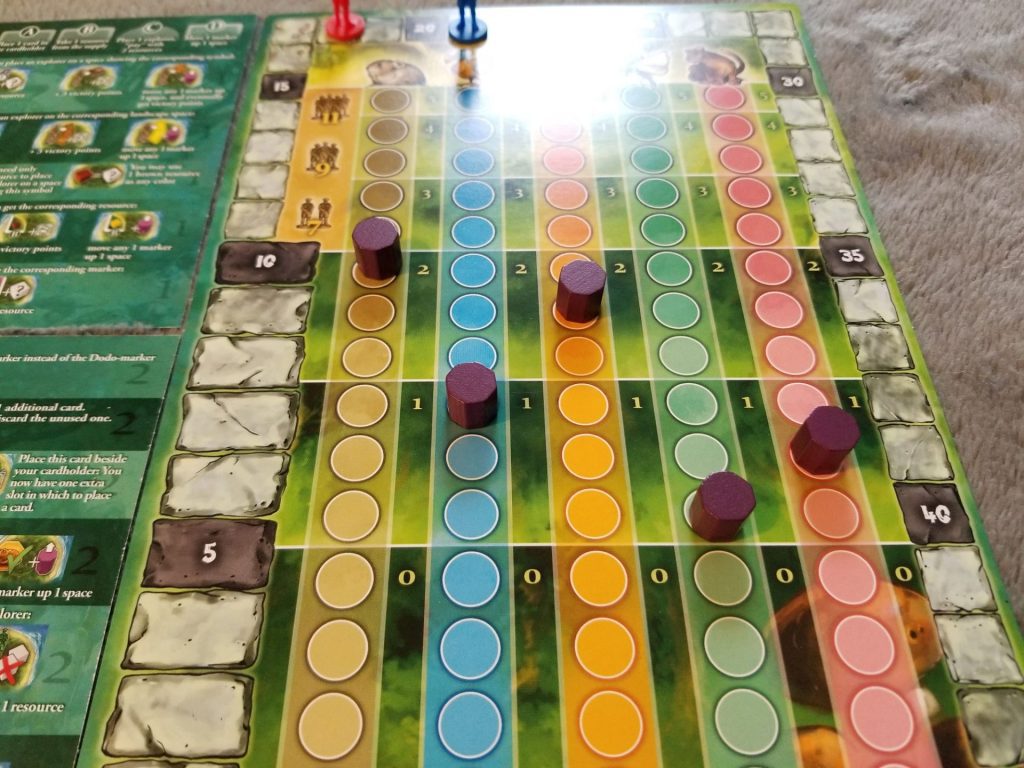
The movement of these markers is controlled by the players’ card play. Here’s how that works:
At the start of each round, every player draws three cards off of the top of the deck. Then they must assign the cards, face down, beneath the lettered slots on their cardholder. Once everyone has chosen their card placement, the cards are revealed. Then each phase is carried out in turn order, one phase at a time.
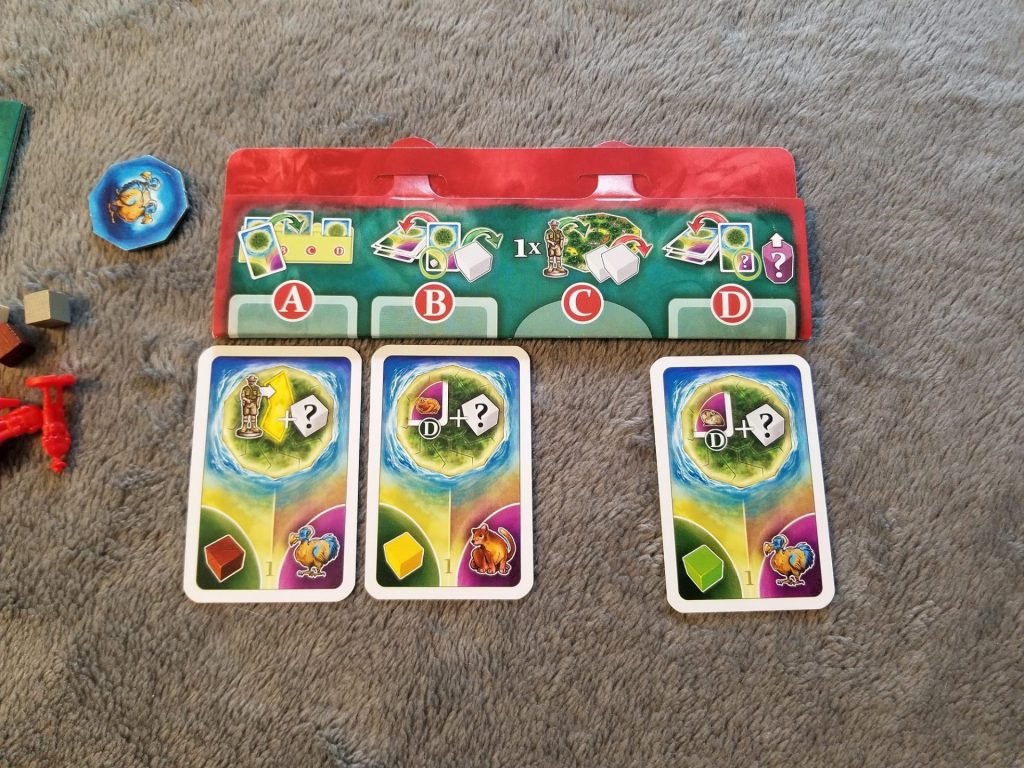
In Phase A, the assigned card will be placed into the player’s cardholder in one of the three card slots. If there are already three cards there, then one of them is covered up by the newly selected card. From this point on, the player will have access to that card’s ability for as long as the card is visible. The benefits these cards provide vary greatly. For instance, some make other actions cheaper, some score additional in-game victory points if certain criteria are met, while others might produce extra cubes. There is an appendix included with the game that explains each card’s benefits. With over ninety different card effects, there’s a wide degree of variability.
In Phase B, the assigned card will generate a cube of whichever color is displayed on the card.

In Phase C, the players will be able to send their Explorers to the island or move Explorers that have already been assigned to a different location on the island. To move an Explorer to a location, a player must pay two cubes matching the color of the target location to the supply. If this should cause an Animal token to become surrounded by that player’s Explorers, the player will collect the Animal token and score points equal to the number printed on the Animal token’s location. Alternatively, the player may opt to not move their Explorer and collect a cube of their choice instead.
In Phase D, the tracking marker matching the animal depicted on the assigned card will move up one space on its track.
All Good Things Must Come To An End
La Isla is played over a variable number of rounds which are divided into four phases. The exact number of rounds depends on the player count as well as how quickly the values change on the Animal tracks. Once the overall value of all the Animal track markers added together reaches a certain value (dependent on player count), the game comes to an end.
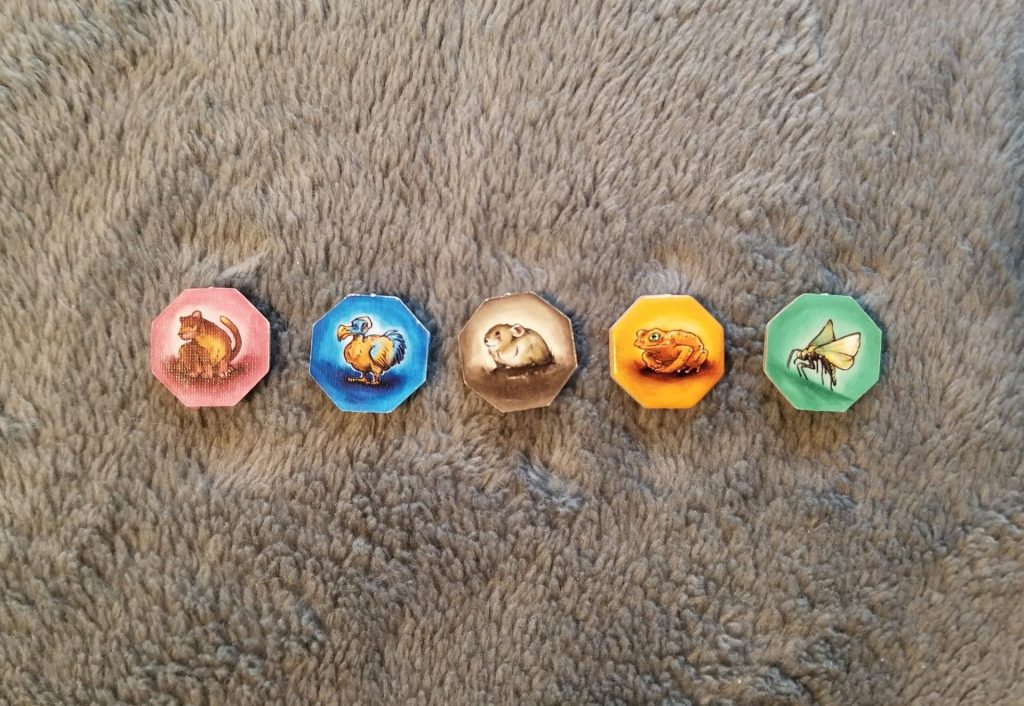
When the game ends, the players will earn ten points for each set of five different animals they have collected, victory points for each Animal token they have collected, and one victory point for every two leftover resources. This total is added to the points they have collected during the game and the person with the most points wins.
Thoughts
If I think about it hard enough, I can usually look back and recall when I first encountered a specific Feld game, but La Isla is the beast that eludes me. I’m pretty certain that my first encounter with it was on Yucata with the acquisition of the physical game coming at a later time, but I also feel like it may have been the opposite way around. What I am not uncertain about is just how much I like this game.
Because, you see, I think that La Isla is one of Stefan Feld’s best. I also think it’s criminally underrated and I’m not sure why.
It isn’t that La Isla gets a lot of flack or negative criticism. It’s just that it doesn’t get talked about as much as many of his other games. Maybe it’s because La Isla was bookended by four critically acclaimed Feld titles just the year before (Bora Bora, Rialto, Bruges, and Amerigo) and Aquasphere the following year. Or maybe it’s because La Isla is just overshadowed by all of Feld’s other more popular titles like the seminal The Castles of Burgundy which is arguably one of the most well-recognized board games on the planet. Whatever the reason, it just ain’t right!
La Isla is a fantastic game.
I think the thing that I like the most about this game is that it’s so easy to teach (I mean, I summed up the game play in just a few tiny paragraphs!), yet it’s jam packed with challenging moments. Feld’s brilliant use of multi-purpose cards forces you to constantly make tough decisions. Sometimes the board game gods smile down on you and all three of your cards fall in line with exactly what you were hoping to accomplish for the turn. But these moments are few and far between. More often than not, at least one of your cards doesn’t fit that vision. Either none of them provide you with the cube you needed or they all force you to raise an Animal track you’re not even competing on. It’s in moments like these that La Isla truly shines. And these moments come at you so frequently that there’s a lot of shining going on.
Do you forgo placing an Explorer to gain a cube? Where do you place your Explorer? Is it worth it to compete over a specific Animal token on the game board or should you redirect your efforts elsewhere? Is your opponent setting up to pick up multiple tokens at the same time? If so, do you try to prevent that by picking up a few of those tokens (or, preferably, all of them) for yourself? And which ability should you replace in Phase A? Do you purposefully raise an Animal token that nobody’s competing for just to bring the game to a quick end so that you can capitalize more efficiently on the tokens you DO have?
There’s just a lot to think about. La Isla tickles your gray cells in very pleasing ways and it does it without a lot of unnecessary convolution. It’s what keeps me coming back for more. If you haven’t played La Isla and have thought about it, then I highly recommend you give it a chance. You might be surprised by what you find. And if it hasn’t been on your radar until just now, then what are you still reading this for? Go get La Isla! You won’t regret it.


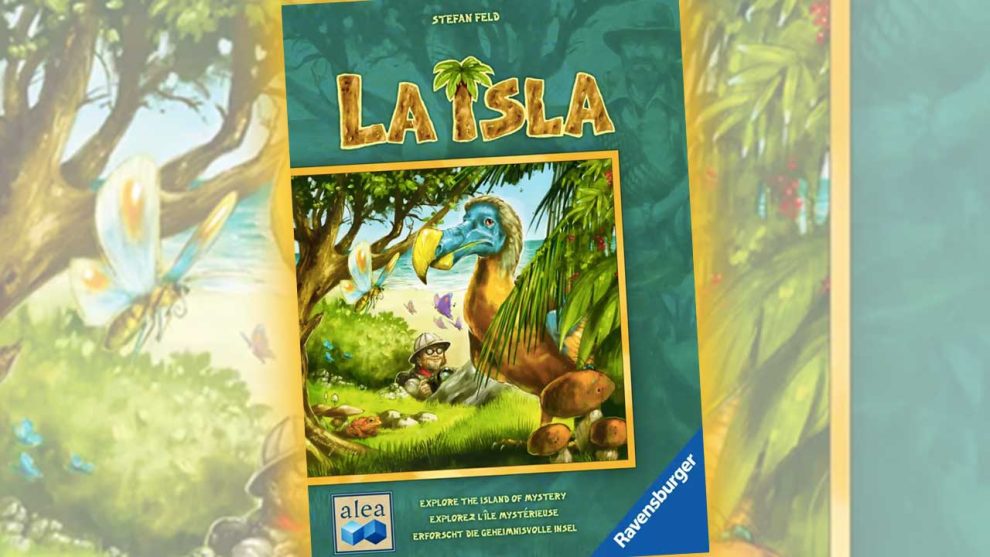


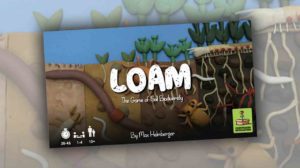
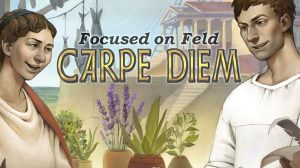





Add Comment